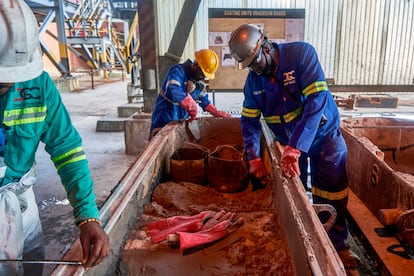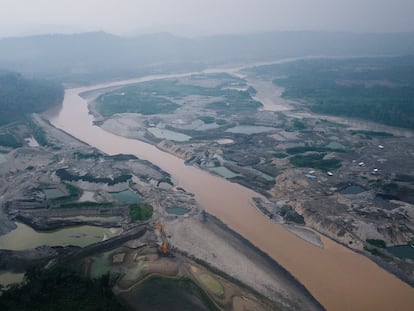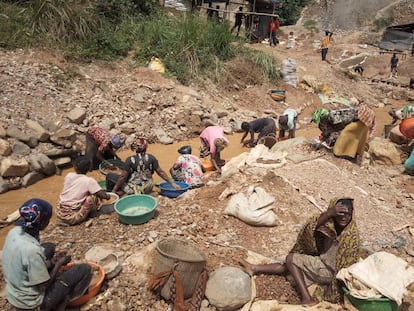Zambia embraces copper (and Silicon Valley)
The mineral is the Hichilema government’s ticket to pay the foreign debt, but financing the exploitation requires a substantial investment


Zambia is one of those countries that is difficult to locate on the African map. The nation does not seem to generate significant economic news stories either. The most recent perhaps is that it was the first African country to default on its foreign debt since the outbreak of the pandemic. However, suddenly Jeff Bezos, Bill Gates, artificial intelligence, Silicon Valley and even the mercenary group Wagner have entered the narrative. All in the name of the country’s core: its copper, one of the essential metals in the green transition — the price per ton is around $8,500.
The red mineral is the major asset that the government of President Hakainde Hichilema, elected in 2021, possesses to tackle the $13 billion it owes to its creditors, which include China. The country has secured a repayment margin extending to 2040. This year, its external deficit will stand at 70% of GDP, for now. Although on October 14 it struck an agreement to restructure a significant part of its $6.3 billion bilateral debt with its creditors, according to Reuters.
Yet it seems that the solution lies beneath the Gambia’s feet. Digging underground to reach it though is a daunting task. Hichilema intends to triple copper production from 800,000 tons per year to some three million tons by 2032. This means surpassing the output produced by the Democratic Republic of Congo (DRC) — Africa’s largest extractor — which is catching up with Peru, the second-largest producer behind Chile.
Reshaping the global metal map requires investment and expensive technology. That involves making a trip to California, all the way to Silicon Valley and KoBold Metals. This artificial intelligence start-up, backed by billionaires like Bill Gates and Jeff Bezos, has invested $150 million to develop the Mingomba copper-cobalt mine in Zambia, which experts claim is the world’s largest untapped deposit of the red metal. Each drill hole uses high-precision technology at a cost of $1 million. “Mingomba will contribute to one of the country’s goals of increasing copper production to three million tons per year,” confirms a spokesman for the Californian company. He adds: “It will take a lot of mining to achieve this, but it can significantly help President Hichilema achieve his objectives.” This is the strategy aimed at resuscitating the economy of a country that has made its mistakes. After the 2020 default, the president’s predecessor, Edgar Lungu, erroneously nationalized the large mines and this resulted in the withdrawal of foreign investment. Mopani reported losses of $300 million last year after the multinational Glencore sold its majority stake to state-owned mining company ZCCM-IH for $1.5 billion in 2021.
This was one misguided approach. With high demand and a drive by investors, previously loss-making subterranean mines are reopening. “Every ton counts,” Hichilema stated last March. “It takes six times more copper to produce an electric vehicle. Perhaps the best way to invest in these cars is in the metal and mining exploitations,” says César Pérez Ruiz, global chief investment officer of Pictet WM. During a conversation with CNN, Kurt House, CEO of KoBold, claimed that “new discoveries, valued at $10 trillion, in lithium, copper, cobalt and nickel” are required if we are to meet the needs of the green energy transition.
This metal glitters like gold and this glimmer of hope must first overcome certain geographic challenges. Its ore may be of the same quality as that of the DRC, but it has to be transported more than 1,800 kilometers, mostly by truck, to ports in Namibia and Tanzania. In return for the distance covered, it offers greater political stability. And when a country has eight neighbors, tranquility alone is good economic news. “As long as Zambia can control its borders, any complications in the DRC’s mineral supply chain, whether from the presence of Wagner mercenaries or other unaccountable organizations, will only make its natural resource exports more attractive,” reflects Eric Werker, professor at the Beedie School of Business at Simon Fraser University (Canada).
Internal problems
Zambia is fortunate when it comes to the subsoil, but first it has to restore order at home. First in the copper belt, the province where the country’s main mines are located. This is the basis of the country’s economy. The historical problem of the miners’ demotivation would be solved with decent salaries. Then there is a second layer — debt repayment has to be balanced with the fight against inequality. This African region needs to protect the profits derived from metal. “Zambia has other pressing development challenges,” warns Eric Werker. “And money from natural resources is required to finance economic and social programs.” In addition, buyers are increasingly looking for supply chains that are environmentally friendly while being fair to workers. Meeting these two rules enables the more expensive metal to be sold to environmentally sensitive buyers such as Tesla or Apple. Right now, such a strategy from the president to put the house in order has brought back control of Konkola Copper Mines (KCM), in a dispute lasting for years, with the Anglo-Indian firm Vedanta Resources.
However, in Mufulira, where Mopani Copper Mines operates the deepest well (1,500 meters) in the province, subterranean explosions are occurring, affecting nearby houses. This is the case in Kankoyo. In this region, the familiar story of a community confronting a mining company recurs. The answer — according to Crimson Chilimelime, a member of the NGO working in the area, Green and Justice, told the Financial Times — is to relocate the residents. Something that can be financed by any new investor in Mopani.
A nation where recycling shines
It is a question of infinitives. In addition to producing, we must recycle. It may not sound familiar to few, but Jubilee Metals Group is a U.K. firm that has turned the last verb into a profitable business in Zambia. It has purchased, so far, more than 260 million tons of metal and tailings (mine waste) rich in copper and cobalt in Kitwe and Luansha. Its purpose is to ensure the refining of 25,000 tons of the mineral in 2025. It has also renovated the Sable refineries in Kabwe and has built a concentrator (processes the mineral) in Ndola. "These plants already produce and sell copper cathodes [sheets] and copper and cobalt concentrates, with a planned capacity of 12,000 tons at the end of the year," calculates Pedja Kovacevic, head of Strategy and Consulting at the British firm. “Given the magnitude of opportunities that the country offers, the ambition does not end there. We hope to contribute our grain of sand to the increase pursued by the government of Zambia." The three million tons of 2032 are not that deep.
Sign up for our weekly newsletter to get more English-language news coverage from EL PAÍS USA Edition
Tu suscripción se está usando en otro dispositivo
¿Quieres añadir otro usuario a tu suscripción?
Si continúas leyendo en este dispositivo, no se podrá leer en el otro.
FlechaTu suscripción se está usando en otro dispositivo y solo puedes acceder a EL PAÍS desde un dispositivo a la vez.
Si quieres compartir tu cuenta, cambia tu suscripción a la modalidad Premium, así podrás añadir otro usuario. Cada uno accederá con su propia cuenta de email, lo que os permitirá personalizar vuestra experiencia en EL PAÍS.
¿Tienes una suscripción de empresa? Accede aquí para contratar más cuentas.
En el caso de no saber quién está usando tu cuenta, te recomendamos cambiar tu contraseña aquí.
Si decides continuar compartiendo tu cuenta, este mensaje se mostrará en tu dispositivo y en el de la otra persona que está usando tu cuenta de forma indefinida, afectando a tu experiencia de lectura. Puedes consultar aquí los términos y condiciones de la suscripción digital.
More information
Archived In
Últimas noticias
Rowan Atkinson tops Netflix at 70: ‘He’s as funny as ever’
Israeli recognition of Somaliland stirs up the Gulf
Tiger Woods turns 50: Will he continue playing on the PGA Tour or take a back seat?
The surreal journey of James Nnaji, the Barcelona youth player selected in the NBA Draft who ended up in the NCAA
Most viewed
- Oona Chaplin: ‘I told James Cameron that I was living in a treehouse and starting a permaculture project with a friend’
- Reinhard Genzel, Nobel laureate in physics: ‘One-minute videos will never give you the truth’
- Sinaloa Cartel war is taking its toll on Los Chapitos
- Why the price of coffee has skyrocketed: from Brazilian plantations to specialty coffee houses
- Chevy Chase, the beloved comedian who was a monster off camera: ‘Not everyone hated him, just the people who’ve worked with him’










































